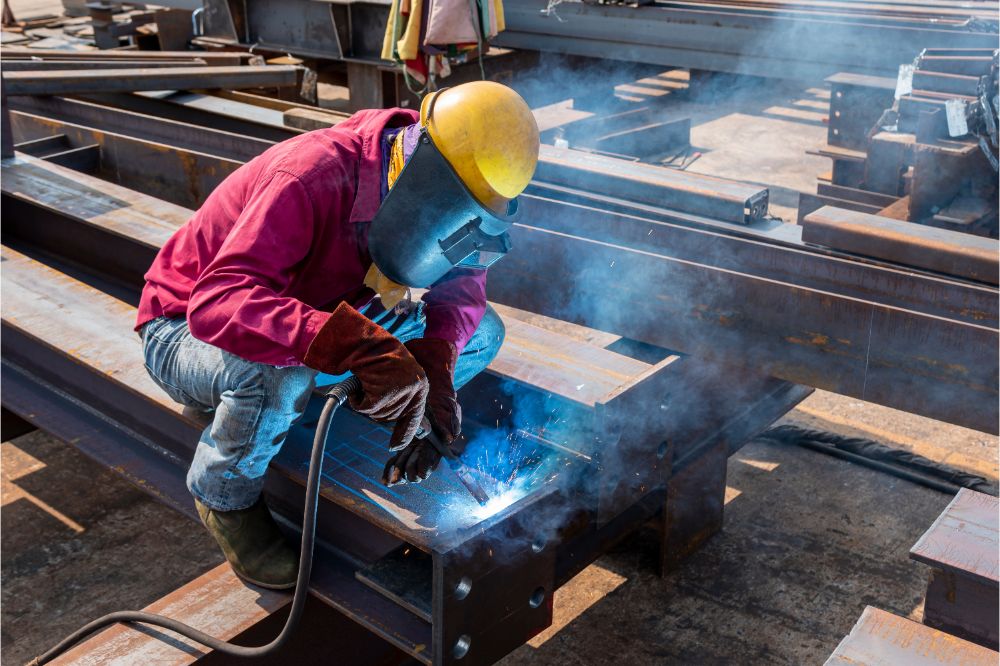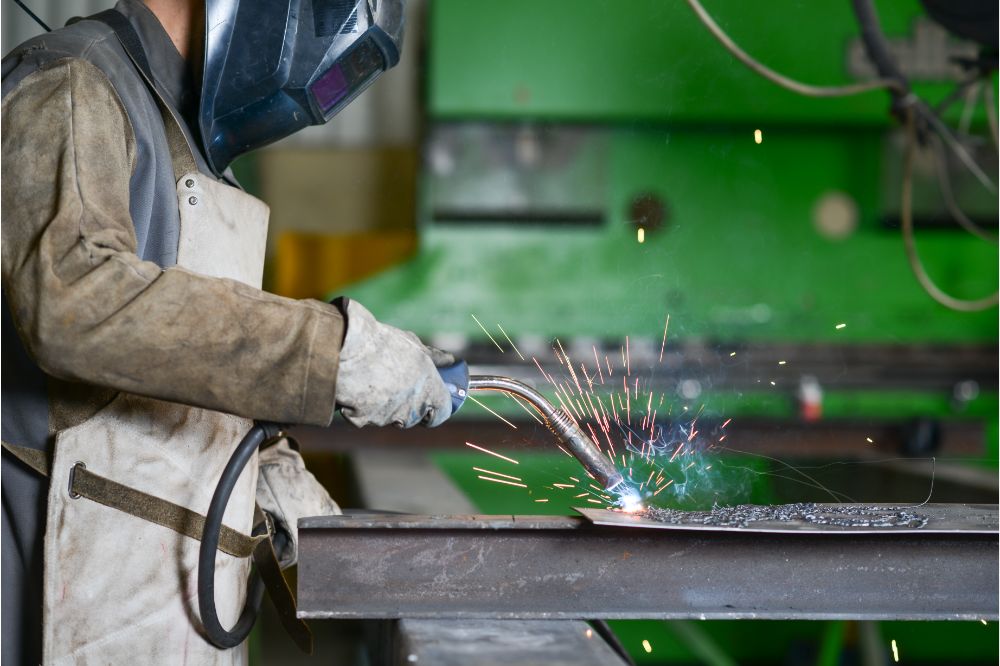Welding is a process of joining two pieces of metal or thermoplastic together using a powerful heat source, pressure, or a combination of the two. There is a wide range of welding techniques, but generally, they can be divided into two main categories: gas-metal arc welding (GMAW) and flux-cored arc welding (FCAW).
Each welding process has its advantages and disadvantages, but they all share one common goal: to create a strong, secure joint between two pieces of material. As a result, welding is used in various industries, including construction, automotive manufacturing, shipbuilding, and aerospace engineering.
Moreover, welding offers many benefits over other methods of joining metals or thermoplastics:
- It creates a stronger bond than other methods, such as brazing or soldering.
- It is a more versatile process than other methods because it is used to join dissimilar materials.
- Welding is faster and less expensive than other methods, such as riveting or bolting.
Another advantage of welding over other joining methods is that it is used to repair damaged or broken components. By adding new material to an existing structure, welders can restore the strength and integrity of the piece without having to replace it entirely. Eventually, it can save both time and money in many applications.
What is FCAW?
FCAW is a tubular wire electrode that is filled with a flux material. The power source for FCAW is also either DC with electrode positive or AC. The FCAW process can be used to weld thick materials and is ideal for out-of-position welding.
How to Perform FCAW?
FCAW type uses a wire feeder to supply a continuously fed electrode to the weld joint. The welding torch supplies an internal shielding gas to protect the weld area from contamination. Certainly, this welding mode is suitable for both thin and thick materials and can be used on metals such as aluminum, stainless steel, and carbon steel with flux.
To perform FCAW, set up your welding machine tool according to the manufacturer’s instructions. Next, select the correct electrode and internal shielding gas composition for your welding material. Set the mode of welding power and amperage according to the thickness of the material you are welding.
Then, grasp the electrode in your non-dominant hand and hold it at a 20-degree angle to the workpiece. Begin feeding the electrode into the weld pool while maintaining this angle. Move the electrode along the length of the seam until you reach the end of your pass.
Finally, remove the electrode from the weld pool and turn off the power. Inspect your weld for defects and make necessary repairs before moving on to your next project.
Pros and Cons of FCAW
Here are some things to consider if you are thinking about using FCAW.
PROS
- FCAW is fast and efficient, making it great for production work.
- It produces less weld spatter than other methods, making cleanup easier.
- Since the wire is fed automatically, it is less likely to break than other methods.
- FCAW welds are made in all positions.
CONS
- The equipment needed for FCAW can be expensive.
- Flux-cored wire can be difficult to find in some areas.
- FCAW welders need to wear special masks to protect their lungs from the fumes produced by the flux core.
What is GMAW?
GMAW is a solid wire electrode fed through a contact tip into the weld pool. The power source for GMAW is either direct contact current (DC) with electrode positive or alternating current (AC). In addition, the GMAW process is used for welding ferrous and non-ferrous metals.
How to Perform GMAW?
The GMAW process is commonly used to weld aluminum, stainless steel, and other non-ferrous metals. To perform GMAW welding, you will need the following:
- A power supply
- An electrode
- A wire feeder
- A work clamp
- Set up your power source, wire feeder, and work clamp according to the manufacturer’s instructions.
- Select the proper electrode for the materials you are welding.
- Connect the electrode to the power source and ground the workpiece.
- Begin feeding the wire into the weld pool.
- Move the electrode along the joint at a consistent speed while maintaining contact with the workpiece.
- Continue feeding the wire until the joint is filled.
- Remove any slag from the weld before cooling it down completely.
Pros and Cons of GMAW
Below, we outline the pros and cons of GMAW so you can decide which method is right for your next project.
PROS
- GMAW is a fast, continuous welding process that produces high-quality welds with minimal operator fatigue.
- GMAW is a highly versatile welding process and can be used on various materials, including aluminum, stainless steel, and carbon steel.
- GMAW welds are less likely to have porosity issues than other welding processes.
CONS
- GMAW requires more expensive equipment than FCAW or stick welding, making it a more costly investment upfront.
- GMAW also requires internal shielding of active gases, which adds to the overall cost of the process.

Major Difference Between GMAW and FCAW
GMAW is a popular arc welding process that uses an electric arc to create a powerful heat source, which melts the metal and joins the pieces together. However, FCAW is a similar process but uses a flux-cored wire drive instead of an electric arc. So, what’s the difference between GMAW and FCAW? Let’s take a closer look.
- GMAW is performed with a continuous wire feed, whereas FCAW uses short, intermittent wires.
- GMAW is generally considered cleaner and more precise than FCAW.
- GMAW is typically used for thinner materials, while FCAW is better suited for thicker materials.
Which is better: GMAW or FCAW?
The debate between GMAW and FCAW has been around for years. Each process has advantages and disadvantages, so the best answer to the question of which is better largely depends on the specific application.
GMAW, or gas metal arc welding, uses an electric arc to create heat that melts the base metal and filler material. The process is relatively fast and efficient and can be performed with various materials.
FCAW, or flux-cored arc welding, is similar to GMAW but uses a different type of electrode. This electrode contains a flux material core that helps shield the weld joints or area from contamination. The process is slightly slower than GMAW but can be more effective in certain applications.
So, which process is best for your particular application? If you need a fast, efficient weld with minimal contamination, GMAW may be the better choice. On the other hand, if you’re working with thicker materials or in a dirty environment, FCAW may provide better results. Ultimately, the decision comes down to understanding the capabilities of each process and choosing the one that best meets your needs.
Electrodes for Welding Processes
There are a variety of electrodes available for FCAW and MIG welding processes. The most common electrode used in FCAW is the E70 series, which is available in numerous sizes and lengths. For MIG welding, the most common electrode used is the ER70S-6. This consumable wire electrode is also available in a variety of sizes and lengths.
The E70 series electrode is made of low-carbon steel and is coated with flux. Ultimately, the flux helps to protect the weld from oxidation and contamination. Thus, the E70 series electrode can be used for all welding positions.
The main difference between the ER70S-6 electrode and the E70 series electrode is that the ER70S-6 has an increased level of deoxidizers. Therefore, it is ideal for welding arcs in dirty or rusty environments. In addition, the ER70S-6 electrode can be used for welding in all positions except vertically down.
Some Specific FCAW Electrodes
There are a variety of FCAW-G (flux-cored arc welding gas) electrodes available on the market, each with its specific purpose. Two of the most popular types are the “HD” (heavy duty) and “SR” (specialty rod) electrodes.
The HD type is designed for heavy-duty applications, such as thick welding plates or high-strength alloy steel. Furthermore, these solid wire electrodes have a higher deposition rate than other types of FCAW-G electrodes, making them ideal for jobs that require a lot of outdoor welding.
The SR type is designed for mild steel applications, such as welding stainless steel or other difficult-to-weld metals. These electrodes have a lower deposition rate than other FCAW-G electrodes, making them ideal for jobs requiring precision welding.
HD and SR-type FCAW-G electrodes are available in various sizes and configurations, so be sure to choose the one that best fits your needs.
Commonly used GMAW Electrodes.
GMAW carbon steel electrodes are commonly used for low-welding carbon and mild steel. They are available in a variety of sizes and types, including GMAW-C carbon steel composite electrodes.
ER70S-4 (Super Arc® L-54) electrodes are made from low-carbon steel coated with a flux layer. It makes them suitable for welding in all vertical and overhead positions. Moreover, they have excellent arc stability and can be used on a variety of bearing materials, including galvanized steel.
E90C-G (Metal shield® MC-900) electrodes are made from high-carbon steel coated with a copper layer. It gives them excellent conductivity and arc stability, making them ideal for welding in difficult or hard-to-reach positions.
Conclusion
Hence, it’s important to choose the right welding for your project. Whichever type of welding you choose, be sure to follow all safety precautions to avoid injury.

